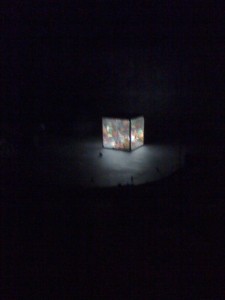Dante’s Inferno by Romeo Castelucci (Festival Grec)
When I was four my dad used to read the Divine Comedy out loud to my sister and me as a bedtime story. He would chuckle to himself at who Dante chose to throw in hell, while we listened in terrified silence. We’d try not to look at the frightening illustrations by Dore’ as Dad read but it was hard to resist. When I fell asleep I would have vivid nightmares with all those damned souls reaching up for me from the boiling hot river of blood.
So when I saw that a production of the Divine Comedy presented in 3 parts was coming to El Grec Festival de Barcelona I immediately bought tickets and tonight is the night for Inferno.
Strange, unsettling sounds swash over us as we find our seats and sit down in the small outdoor ampitheater. The sounds are annoying, like fingernails on a chalkboard and crackly white noise which could be interpreted to be flames. They are impossible to ignore. We sit down, uneasy, with everyone else. The stage is black, with the words Inferno written in block letters, which are taken away one at a time by an anonymous figure dressed in black while the soundscape of ear-splitting crashing, hissing, rumbling and booming slowly fades. The lights go out and we hear barking. It is soon revealed that there are 8 German Shepherds tied to black boxes, barking, frothing and lunging from their chains. We notice a man on stage dressed in black. As the light shines on him he says: “I am Romeo Castellucci, the author of the play you are about to see”. We hear more dogs barking offstage, as they are let loose, one at a time to attack the playwright to the accompaniment of exaggerated sound effects. It is stunning to witness someone being ripped to shreds by a pack of dogs. It is clear this is the artist’s hell, the inferno to which an artist is condemned.
The dogs are taken away as we transition to the next scene, where a man dressed in black climbs the literal sheer cliff of the Montjuic El Grec ampitheater. Again, exaggerated sound. A spotlight is on him, all the way to the top of the rocky wall, on up the trees of the park behind the amphitheater to the top of the highest tree. This is impressive! From here he drops a basketball, which somehow becomes a visual metaphor throughout the play. Exaggerated sound of ball bouncing. There is a kid below who bounces the ball and leaves the stage while bouncing it.
A chain gang of about 30 people of all ages kick the the stone cliff. It sounds hellish, over and over again, kicking the wall with amplified sensurround sound, provoking personal reflection.
Castelucci wrote this piece with the intention of adapting it to whatever city stage it plays in. I later find this Youtube clip taken from a performance of this same play in France, which I insert here because its really amazing how he can adapt that concept of scaling to the top, in this case to the top of a cathedral:
A mass of lost souls moves around the stage, emerging briefly as individuals only to be subsumed again in the crowd of lost identities. A running theme and reminder that death is a leveller.
A bewildered Andy Warhol, replete with Polaroid camera, rolls around on a wet floor and points upwards to a series of televisions. Warhol is Virgil (the Roman poet who guided Dante in The Divine Comedy) but also reminds me of Lucifer. When I think about it, Warhol was the first to seek hell in the surface of things, in banality. I’m sure this must be Castellucci’s point.
A huge black and shape-shifting entity escapes from an upstairs casement. A big box about 30 square meters is slid to center stage. It is covered in black fabric, which is pulled away to first reveal a box with mirrors for sides, but then the mirrors disappear (how?) to reveal children blithely playing inside; bouncing balls, jumping, somersaulting giggling. The stage is big and black, and only the playpen of toddlers is lit up. We see a menacing blob of black fabric slowly oozing towards the box, like cancer and slowly envelop it. The box of children is silently pushed off stage. Again, all we see is a black stage.
A grand piano is set on fire. We watch helplessly as it burns. This really upsets me, because I miss my baby grand back home in Hollywood. A simple 3 note melody with popping piano strings is accompanied by cello plus crackly fire sounds.
A white stallion appears on stage, a nearly invisible person pours very red paint on it, dripping like blood only more poetic.
I’m not sure of the chronology of the images. Numerous individuals, like refugees or displaced persons, lost souls in brightly colored everyday clothes; men and women and children of all ages, move through the bleak landscape. We witness a vast display of mankind subjected to various forms of modern catastrophe.
At one point we in the audience are covered by a protective ceiling of white gauze, the lights are on us, and the stage is obliterated. Its a magical moment which frightens some members of the audience who flee before the fabric covers them. For the rest of us it is a fun moment, in which only we exist. It feels impromptu, and is for me a highlight moment. The image of all our arms reaching up is very visually reminiscent of the illustrations of Doré in the hardbound copy my Father used to read to me as a kid.
The performance ends with a car crash.






Recent Comments